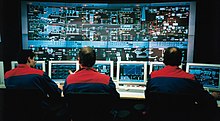Control room

A control room (also called control room , control room or measurement room ) is a technical facility ( control facility ) that supports people in managing a process . It is part of a control system .
In this context, management is “the entirety of all measures that bring about a desired course of a process in terms of defined goals ” ( DIN 19222 ). The measures are mainly taken with human participation based on the data obtained from the process or from the environment with the help of the control system. Target values , target states or quality criteria can be goals here. A control center therefore has one or more devices or connections to devices for measuring , regulating , controlling , displaying , alarming , registering, switching or computing .
There are control rooms for production, for the management of processes, manufacturing control stations for production lines or workshops manufacturing , power plant -, network -, building - and traffic control stations, control centers for the Space Transportation (Satellite / Space shuttle), for environmental monitoring and for military operations . Example: control center of an anti-aircraft gun ; this is z. B. for security reasons usually a piece away from the flak. Some large flak towers have separate towers next to them on which are control rooms for the flak. A command post is also a kind of control center. Military control centers for the combat use of unmanned missiles such as cruise missiles and aerial drones are gaining in importance .
The design of a control room (or control room) requires great care. The operator should have everything in view. All command elements should be easily accessible.
There has been a technical development that can be divided into two areas:
- the use of discrete control modules and command transmitters with the additional visual representation in display layouts and alarm and message panels. The control room consisted of fields with controllers, recorders, signal lights, command transmitters, etc. and a schematic flow diagram above that explained the process context.
- With the advent of control systems with screens (monitors), keyboards and integrated microprocessors since the mid-1970s (Honeywell, System TDC 2000), one task after the other was switched to these new control centers. A modern control room usually has corresponding consoles with several screens. The lack of clarity of a screen in comparison to the large display images that were visible to all operators at the same time was often complained about. Therefore, in addition to the displays on the monitors, such large flow pictures can still be found today.
Importance in the power plant
The control center in the power plant is of particular importance . In it, as a central collection of all relevant plant and running procedural information and readings together, which in various places in the power plant measured are.
The transmission of the measured values to the control room takes place through a power interface because of the great distances from the measuring points and the electromagnetic interference fields . In the control room of a modern power plant, for example, several thousand drives on fittings and other machines with their associated measuring points are monitored, controlled and regulated .
In a nuclear power plant , another task of the control room is to protect the operating personnel from excessive radiation in the radiation protection area. Because of the complexity of the processes to be monitored, a power plant control room must meet the principles of high reliability and ergonomics to a special degree .
The work of the operating personnel in the control room of a power plant requires a high level of qualification . It is imparted in a company-based vocational training course at the power plant. In addition, there is a power plant school and a simulator center in Essen- Kupferdreh for training and further education , where operating scenarios of a power plant can be simulated from normal cases to disasters in true-to-original replica control rooms .
In the early years of electrical energy technology, it was customary to design the control rooms of the power plants in a representative manner. Their switchboards were often made of marble. An example of this that has survived to this day is the machine hall of the Zollern colliery in Dortmund.


